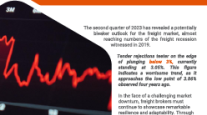Staff Reporter
Spot Market Struggles With Prolonged Bottom

[Stay on top of transportation news: Get TTNews in your inbox.]
The spot market has become stuck in a stagnant bottom with market patterns preventing it from building back momentum.
“I think it’s definitely bottomed out, there’s no question,” said Dean Croke, principal analyst with DAT Freight and Analytics. “It’s just been a very lackluster year without a lot of momentum. There hasn’t been a lot of trends that have stuck. We see some peaks and valleys week after week and nothing really sustained.”
Croke noted that spot rates have struggled to gain momentum since bottoming out four weeks ago. He added that produce season typically lifts spot rates by about 18 cents a mile, but this year, rates only increased by an average of 10 cents.
“Spot rates decelerating into July 4 is not a good sign for carriers for the rest of the year because it’s just shaping up more and more like 2019 did, which was really just a year of fairly flat and slowly declining spot rates,” Croke said. “That forced a lot of carriers out of the industry.”
Arrive Logistics released a report noting there have been some upticks in spot rates since May. But the multimodal transportation and technology company believes that pattern has more to do with seasonal volatility than a fundamental shift in market conditions.

Spencer
“We’ve certainly seen overall opportunity in the spot market down on a year-over-year basis,” said David Spencer, vice president of market intelligence at Arrive Logistics. “I think compared to historical levels, it’s probably in line with where we’ve seen things on average.”
ACT Research noted in a report June 14 that April likely will mark the bottom of the spot rate down cycle. But the report also warned that elevated Class 8 build rates will limit the near-term upside. It noted the freight market appears close to balance, but the rebalancing so far has been mainly on the labor side.

Denoyer
“Spot rates rose in May, but strong new equipment production will slow the ascent initially,” said Tim Denoyer, vice president and senior analyst at ACT. “Though equipment capacity is still growing, labor capacity is tightening as some fleets shrink and others exit. Aside from the pandemic capacity shock in April 2020, we are on track for a record contraction in labor capacity this year, which is key to the bottoming process.”
Spencer doesn’t expect to see anything more significant, such as seasonal demand surges, in the foreseeable future. He anticipates that the spot market is going to continue as it has for much of the year, with sufficient capacity to meet the demand.
“Such that we see rates sort of dredging along the bottom,” Spencer said. “I think where we reached probably in late April or early May is what we call the bottom. I think that’s the absolute bottom for spot rates, and they’ll go up and down with seasonal ebbs and flows. But I don’t think we’re looking at any sort of fundamental sustained elevation to spot rates until we see some sort of disruption or market shift.”
Spencer suspects seasonal trends will continue but much more muted than normal. He noted back-to-school items are already moving into position, and there will be an uptick when peak shipping season hits.

Hutto
“Even though the rates aren’t where carriers would like them to be, there’s still plenty of freight to be moved, so there’s still profit to be had,” said Brent Hutto, chief relationship officer at Truckstop. “We’re not at a point in any one of the segments, whether its van, reefer or flatbed, that truckers are going to go out of business like crazy.”
Hutto doesn’t see the current spot market as hitting bottom, but rather normalizing. He noted freight has been relatively normal with some minor ups and downs since October 2022. But he does warn that carriers have to be able to run efficiently.
“Are we going to have a little bit of a seasonal bump potentially into the holidays?” Hutto said. “Certainly, we will. Will it be at the same amplitude — in other words, is it going to go as high as it normally goes? The predictions are probably not because we came off of a really extreme high.”
Want more news? Listen to today's daily briefing above or go here for more info
Croke believes the weaker conditions could be a sign of normalization. The problem is, there is still too much capacity in the market relative to how much freight is available. He noted that decreasing diesel and operational costs have allowed more carriers and owner-operators to keep going, but the elevated capacity has put downward pressure on rates.
“I think it won’t be a demand event that changes this market; it will just be a continuation of carriers that leave the industry,” Croke said. “And then at some point when demand picks up, maybe in the fall, around peak shipping season, back-to-school and holiday retail season, we’ll start to see the market turn where there’s more loads than there are trucks.”




